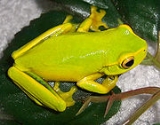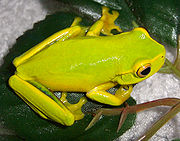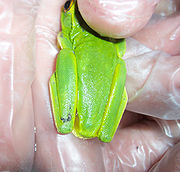
Lost frog
Encyclopedia

Frog
Frogs are amphibians in the order Anura , formerly referred to as Salientia . Most frogs are characterized by a short body, webbed digits , protruding eyes and the absence of a tail...
s which have been, usually accidentally, outside of their original distribution.
The term mainly applies to Australia
Australia
Australia , officially the Commonwealth of Australia, is a country in the Southern Hemisphere comprising the mainland of the Australian continent, the island of Tasmania, and numerous smaller islands in the Indian and Pacific Oceans. It is the world's sixth-largest country by total area...
, due to the large amount of frogs (up to 10,000 a year) accidentally while hiding in fruit
Fruit
In broad terms, a fruit is a structure of a plant that contains its seeds.The term has different meanings dependent on context. In non-technical usage, such as food preparation, fruit normally means the fleshy seed-associated structures of certain plants that are sweet and edible in the raw state,...
produce, flowers and building
Building
In architecture, construction, engineering, real estate development and technology the word building may refer to one of the following:...
and landscape
Landscape
Landscape comprises the visible features of an area of land, including the physical elements of landforms such as mountains, hills, water bodies such as rivers, lakes, ponds and the sea, living elements of land cover including indigenous vegetation, human elements including different forms of...
supplies. Most of the lost frogs each year are moved from Northern Australia to the larger cities in the south.
The majority of the lost frogs turn up in fruit shops and markets. These frogs are often released into the surrounding areas. The release of lost frogs into areas far from their original habitat can have devastating effects on the released frog or the local frog populations. As lost frogs often end up moving from tropical to cooler areas they often cannot adapt fast enough to the new climate, and due to the stress of travelling hundreds of kilometres, often suffer injuries and are likely to die. Lost frogs are also often responsible for the spread of disease. When a frog suffering from a disease is released into an area where the disease is not present, it can have severe effects on the local frog populations. The fast spread of the Chytrid fungus around Australia was likely to have been assisted by the introduction of lost frogs into areas where the disease was absent.
Frog rescue

Quarantine
QuarantineQuarantine
Quarantine is compulsory isolation, typically to contain the spread of something considered dangerous, often but not always disease. The word comes from the Italian quarantena, meaning forty-day period....
is extremely important in the management of lost frogs. It involves holding the frog separate from others in an esstially bare container, with nothing more than a water dish, a hiding place and food. The frogs must be checked regularly for any evidnece of disease and to monitor injury. Once the quarantine period is over the frog still cannot be released into the wild, because it is extremely difficult to track down the exact location where the frog originally came from. Most lost frogs are then sold to people willing to look after them or who want a frog as a pet. The Hygiene Protocol for Control of Disease in Frogs, should be followed when dealing with lost frogs, it was written by the National Parks and Wildlife Service
National Parks and Wildlife Service (New South Wales)
The National Parks and Wildlife Service is part of the Office of Environment and Heritage - the main government conservation agency in New South Wales, Australia....
and is recognised as one of the best guides for prevent the spread of the Amphibian Chytrid fungus.
Lost frog species
The majority of lost frogs are tree frogs, as these frogs often live in bananaBanana
Banana is the common name for herbaceous plants of the genus Musa and for the fruit they produce. Bananas come in a variety of sizes and colors when ripe, including yellow, purple, and red....
plantations, and are moved with the bananas when they are cut down for shipping. Therefore the majority of frogs that end up becoming lost frogs are:
- Dainty Green Tree FrogDainty Green Tree FrogThe Dainty Green Tree Frog or Graceful Treefrog is a tree frog native to eastern Queensland, and north-eastern New South Wales, Australia. It ranges from northern Cape York in Queensland to Gosford in New South Wales, with a small and most likely introduced population in Hornsby Heights in Sydney...
(Litoria gracilenta)—also known as Banana Frogs for this exact reason - Green Tree FrogWhite's Tree FrogThe Australian Green Tree Frog, simply Green Tree Frog in Australia, White's Tree Frog, or Dumpy Tree Frog is a species of tree frog native to Australia and New Guinea, with introduced populations in New Zealand and the United States. The species belongs to the genus Litoria...
(Litoria caerulea} - Eastern Dwarf Tree FrogEastern Dwarf Tree FrogThe Eastern Dwarf Tree Frog , is a small and very common tree frog found on the eastern coast of Australia, from around Cairns, Queensland to around Ulladulla, New South Wales. Individual frogs of this species are often found in having been accidentally relocated via transported fruit boxes...
(Litoria fallax) - White Lipped Tree FrogGiant Tree FrogThe White-lipped Tree Frog , also known as the Giant Tree Frog, is the world's largest tree frog. This species is native to the rainforests of Northern Queensland, New Guinea, the Bismarck Islands and the Admiralty Islands....
(Litoria infrafrenata) - Peron's Tree FrogPeron's Tree FrogPeron's Tree Frog, Emerald Spotted Tree Frog, Laughing Tree Frog or the Maniacal Cackle Frog is a common Australian tree frog of the genus Litoria.-Physical description:...
(Litoria peronii)
In building and landscaping materials ground frogs are the main species which are transported; the Spotted Grass Frog
Spotted Grass Frog
The Spotted grass Frog or Spotted Marsh Frog is a terrestrial frog native to Australia. It is distributed throughout all of New South Wales and Victoria, eastern South Australia, the majority of Queensland and eastern Tasmania...
(Limnodynastes tasmaniensis) is well known for being moved long distance in such materials. There are colonies of this species in areas far from their native range, which are thought to be the result of their accidental transportation.
Cane Toad
Cane Toad
The Cane Toad , also known as the Giant Neotropical Toad or Marine Toad, is a large, terrestrial true toad which is native to Central and South America, but has been introduced to various islands throughout Oceania and the Caribbean...
s (Bufo marinus) are also known to become lost frogs, however they can usually adapt to change, and often do not die once they reach their destination. The movement of Cane Toads in building material is one of the causes for the spread of the species around Australia. Populations of Cane Toads ahead of their main frontier, such as the former population at Port Macquarie
Port Macquarie, New South Wales
Port Macquarie is a city on the Mid North Coast of New South Wales, Australia, located about north of Sydney, and south of Brisbane. The city is located on the coast, at the mouth of the Hastings River, and has an estimated population of 44,313....
, are believed to be displaced toads moved from areas in Queensland
Queensland
Queensland is a state of Australia, occupying the north-eastern section of the mainland continent. It is bordered by the Northern Territory, South Australia and New South Wales to the west, south-west and south respectively. To the east, Queensland is bordered by the Coral Sea and Pacific Ocean...
.

